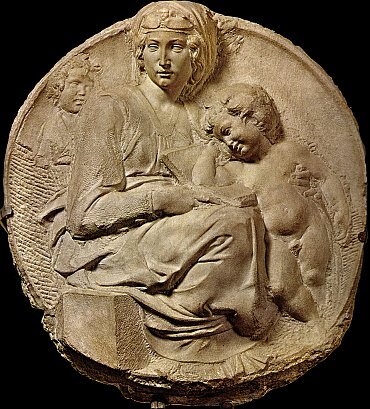The Tondo Pitti by Michelangelo

The Tondo Pitti is a marble bas-relief realized by Michelangelo between 1503 and 1504 and hosted at the National Museum of the Bargello in Florence. It is one of the most important works done by the artist, one of the most famous, dating from the same years in which Michelangelo was carving the David. While working on his most famous statue, the artist was in fact devoted, in the meantime, to a private, more profitable commission. It was a work performed for Bartolomeo Pitti, whose son Miniato, monk in Monteoliveto, gave it to Luigi Guicciardini (1487-1551). The work was later bought by the Florentine Galleries in 1823 from the antiques shop of Fedele Acciai and placed first in the Uffizi and then at the Bargello Museum in 1873.
The tondo represents Mary with an open book on his lap, looking away in the distance like meditating on the gloomy and sad fate of his son just read in the prophecies of the Holy Scriptures. The child gently leans on her and, in the background, it appears St. John. At the center of the composition there is Maria, sitting on a cubic block. On her front a cherub symbolizes the awareness of the truth just read on the prophecies. She has a role of great importance and much of the space within the work. The Virgin seems almost folded in on herself to get into the tondo, but at the same time she gives the impression of wanting to emerge, freed by force from this cramped space.
One of the most important features of Michelangelo's Tondo Pitti is the connection between the three figures, all linked to each other even if on three different levels, which is very reminiscent of the style of Leonardo Da Vinci from which probably Michelangelo was inspired after seeing the cardboard Sant'Anna, exposed in those years at the Annunziata. Another important characteristic of Michelangelo's work is the "unfinished", here visible in the raw contours of the work. A technique that symbolically revokes the imperfection of man that will never be perfect in all its parts.











